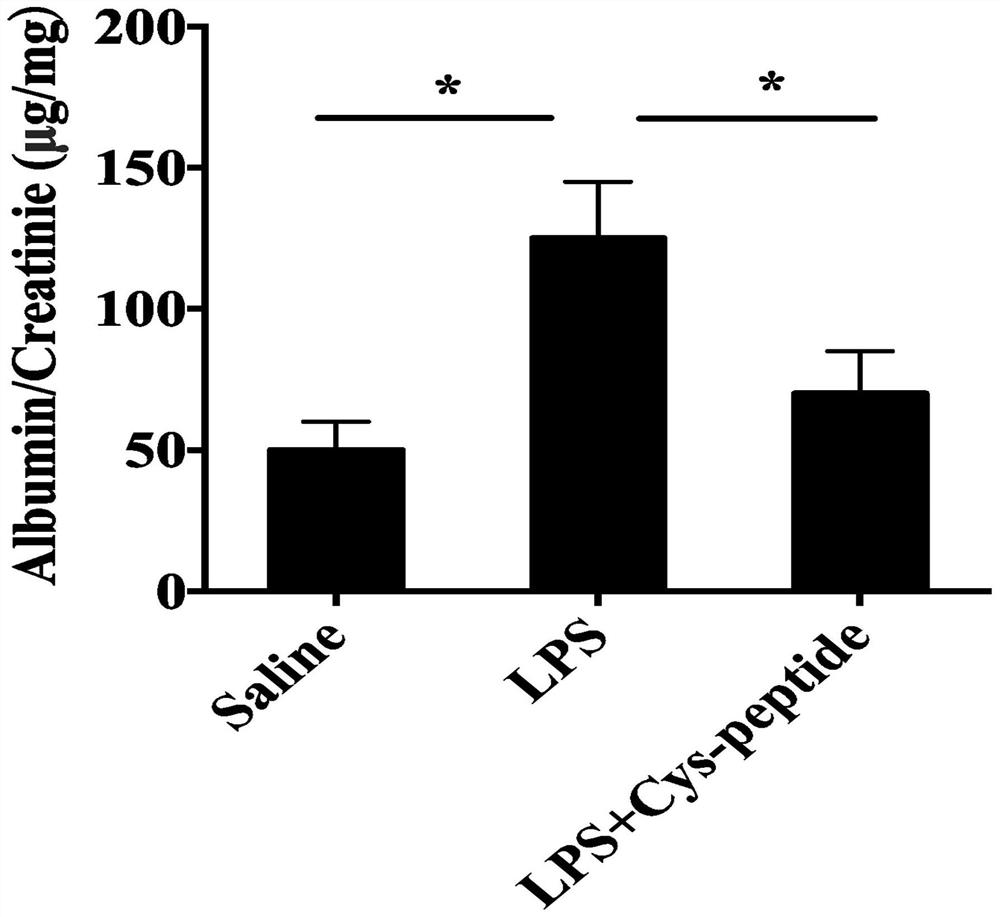Application of a novel polypeptide for improving placental dysfunction in preeclampsia
A technology for dysfunction and preeclampsia, applied in the field of medicine, can solve problems such as maternal and fetal side effects, and achieve the effects of good stability, improvement of proteinuria symptoms, and good lipophilicity
- Summary
- Abstract
- Description
- Claims
- Application Information
AI Technical Summary
Problems solved by technology
Method used
Image
Examples
Embodiment 1
[0025] Further, the application of the polypeptide in the medicine or medicament for improving placental dysfunction in preeclampsia, wherein the polypeptide and the polypeptide composition can be made into any pharmaceutically acceptable dosage form.
[0026] Rats were housed in a light- and humidity-controlled environment, with free access to food and tap water, and were acclimated to these conditions for a week. Fertile females and males were reared at a 1:1 ratio overnight, and plugs were collected in the morning, as in Presence confirms pregnancy and this day is GD0. At 14 days of gestation, pregnant mice were randomly assigned to three groups. Group 1 (Saline) (n=10): On day 14 of gestation, each rat received normal saline (1 mg / kg) via tail vein; Group 2 (LPS): On day 14 of gestation, LPS was injected via tail vein (1 μg / kg); Group 3 (LPS+Cys-peptide): On the 14th day of gestation, the rats were first treated with LPS (1 μg / kg) via the tail vein, and then administered ...
Embodiment 2
[0033] Further, the application of polypeptide in reducing the level of urine protein / creatinine in pregnant mice with preeclampsia.
[0034] Sprague-Dawley (SD) rats (10-12 weeks, 280-350 g) were purchased from the Experimental Animal Center of Nanjing Medical University. Rats were housed in a light- and humidity-controlled environment with ad libitum food and tap water ad libitum.
[0035] After one week of acclimatization, fertile females and males were reared at a ratio of 1:1 overnight, and plugs were picked up in the morning. If they were present, pregnancy was confirmed, and this day was GD0. (Under standard laboratory conditions (temperature 23-26°C, relative humidity 50-60%, irradiation between 06:00am and 06:00pm), free access to pelleted food and water)
[0036] On day 14 of gestation, pregnant rats were randomly assigned to three groups: group 1 (Saline) (n=10): on day 14 of gestation, each rat received saline (1 mg / kg) via the tail vein; group 2 (PE) Rats were i...
Embodiment 3
[0041] Further, the application of polypeptide in improving the utilization rate of placenta in pregnant mice with preeclampsia.
[0042] Prague-Dawley (SD) rats (10-12 weeks, 280-350 g) were purchased from the Experimental Animal Center of Nanjing Medical University. Rats were housed in a light- and humidity-controlled environment with ad libitum food and tap water ad libitum.
[0043] After one week of acclimatization, fertile females and males were reared at a ratio of 1:1 overnight, and plugs were picked up in the morning. If they were present, pregnancy was confirmed, and this day was GD0. (Under standard laboratory conditions (temperature 23-26°C, relative humidity 50-60%, irradiation between 06:00am and 06:00pm), free access to pelleted food and water)
[0044] On day 14 of gestation, pregnant rats were randomly assigned to three groups: group 1 (Saline) (n=10): on day 14 of gestation, each rat received saline (1 mg / kg) via the tail vein; group 2 (PE) Rats were inject...
PUM
 Login to View More
Login to View More Abstract
Description
Claims
Application Information
 Login to View More
Login to View More - R&D Engineer
- R&D Manager
- IP Professional
- Industry Leading Data Capabilities
- Powerful AI technology
- Patent DNA Extraction
Browse by: Latest US Patents, China's latest patents, Technical Efficacy Thesaurus, Application Domain, Technology Topic, Popular Technical Reports.
© 2024 PatSnap. All rights reserved.Legal|Privacy policy|Modern Slavery Act Transparency Statement|Sitemap|About US| Contact US: help@patsnap.com










